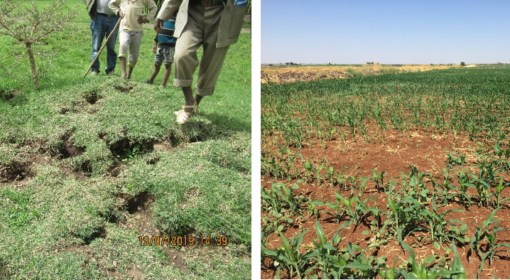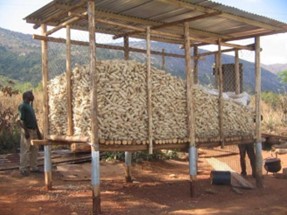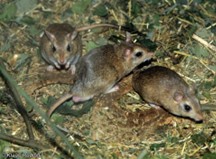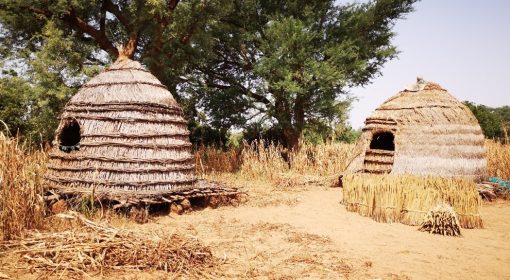Authors: Luwieke Bosma, Yuka Nabae and Marina Vara
Rodents, mainly rats and mice, have always caused damage to agricultural products and are the vectors for numerous diseases. The presence of rodents is a significant issue for many farmers worldwide. Especially in developing countries, rodents’ damage to crops is a massive problem for food security, where smallholder farming families are particularly vulnerable. Rodents are responsible for 5-10 % loss of food grains annually in India (Kumawat et al., 2016). Rodents damage crops by destroying tillers and storing them in chambers within their burrows. This damage occurs both before and after harvesting periods (Chattopadhya et al., 2010). In India and Pakis tan, the common rodent species B. bengalensis hoards wheat and rice in their burrows (Maqbool et al., 2011). Inflicting 20–40% yield loss to cereals (Pakistan), up to 30% to wheat (Bangladesh), and 5–22% to rice (India) (Tripathi, 2014). They typically invade rice fields one to two weeks before harvest, establishing burrow systems after the last irrigation water has drained (Phukon, 2019).
People recognise that rodent activities can cause extensive damage to organic production systems (Khanam & Mushtaq, 2021). Organic agriculture is an approach that does not use chemical farming inputs or genetically modified crops or animals. It is more difficult for organic farmers to control a rodent population than conventional because organic farming practices often provide better conditions for rodents: a heterogeneous landscape, food source and habitat.
This blog explores the potential for harmonising organic farming with effective and sustainable rodent management. It is important to find out how Ecologically-Based Rodent Management (EBRM) and organic farming practices can work toward a common goal of increasing yields and growing healthier crops through biological and ecological management (Jacob & Eccard, 2018).
EBRM promotes a detailed understanding of the behaviour and population ecology of the target rodent pest species so that management can be targeted for specific environments at crucial times with minimal risk to non-target species. The emphasis is on low reliance on chemical rodenticides, focusing on community action. According to Singleton et al. (1999), EBRM follows the same fundamental goals as Integrated Pest Management (IPM) :
- Minimising adverse effects on non-target species and preventing environmental contamination
- Developing an approach that is economic for the farmers in both developing and developed countries
- Establishing an approach that is feasible for local farmers.
Rat behaviour and habitat functions
To understand rats better, we highlight some behavioural aspects. Rats are typically nocturnal animals and are primarily terrestrial. Most rat species are proficient, some even expert swimmers, and can forage in aquatic environments. Rats create burrows, nests under boulders, decaying tree trunks, or various shelters on the forest floor. They seek refuge in rock crevices, caves, and even human dwellings, ranging from small huts to large city buildings.
While the common belief is that rats will eat anything, their diets vary by species and habitat. Some rats, including insects and worms, prefer a carnivorous diet, while others mainly eat fruits and seeds. Rats that share living spaces with humans are known for eating almost anything, but they are particularly fond of stored grains. They usually move within 30-100 metres of their shelter each day, depending on food/mate availability. During the summer, rodents stay in bunds, dykes, water channels, fallow and uncultivated lands or in fields of long-duration crops such as sugarcane and tree plantation.
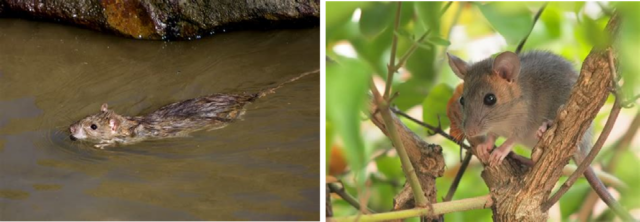
Rats commonly exhibit neophobic behaviour, making them cautious of new objects and situations. This caution contributes to their tolerance to chemical rodenticides. While rodents lack physiological resistance to zinc phosphide rodenticides, they have learned to avoid them after experiencing sublethal doses. This leads to a typical behaviour where rats do not consume lethal doses. Their inability to vomit further enhances their caution when encountering new foods or substances.
Table 1: Behavioural Characteristics of Rodents (Tripathi, 2014).
| Attributes | Characteristics |
| Sight | Colourblind, but can distinguish between shades. They can discriminate between pattern and size and have good perception. |
| Hearing, smell and touch | Well-developed senses readily distinguish unusual noises, and the long whiskers on their muzzle and guard hairs on the body serve as sensitive feelers. |
| Balance | Excellent balancing sense enables them to run on pipes, narrow ledges or wires. Long tails act as balancing organ. |
| Gnawing | Gnaw to gain entrance to food and wear down their incisors to keep them sharpened. |
| Climbing and swimming | They can climb almost anything they can get their claws to hold. Many rats are excellent climbers, where specific species like bandicoot and musk rats are excellent swimmers. |
| Temperament | Bandicoots and Norway rats are much more aggressive than house rats and mouse. Cannibalism is quite common. |
| Travel routes | They use fixed pathways, and usually moves along the walls, under floors or through thick grass or litter |
Rats of many tropical species breed year-round; however, breeding is linked to specific wet seasons or the summer months in some species. Most rodent outbreaks have a common trigger; this can be a rapid increase in food supply, suitable breeding sites, and the presence of rodent species that have adapted well to an environment modified by humans (Singleton et al., 1999).
Integration of EBRM and organic farming
It is more difficult for organic farmers to prevent rodents from managing the rodent population because organic farming practices often provide a heterogeneous landscape, food source and habitat. For example, a stone bund is needed to control water and maintain soil moisture, but on the other hand, it forms hiding places, shade and water sources for rodents.
Here, we will explore a set of organic farming practices and EBRM and their interconnection with each other. Check out this rodent control manual for more detailed information on EBRM methods. The table describes what impact it has on rodents per organic farming practice and how EBRM could be integrated to achieve “rodent proofing” of that practice. This often means a bit of tweaking, though some organic farming practices conflict with rodent control. For those, we suggest adding rodent management options for mitigation purposes.
One innovative method developed under MetaMeta Research’s guidance is a 100% plant-based rodenticide that is biodegradable, environmentally safe, and without instant kill, thus avoiding bait shyness and making it sustainable for long-term use.
| Organic farming practice | Main purpose | Impact on rodent | EBRM method integration |
| Stone and soil bunds | Soil and Water conservation, | Functions as rodent shelter | Reduce bund dimensions; rats prefer thick bunds with more height for burrowing/sheltering. Soil bunds of <30cm wide make it difficult for rats. Likewise, compact stone bunds well anchored in the ground, with a break every 10m, limit habitat options for rats. Leave a strip of open land next to the bunds to expose rats to predators while moving between stone bunds and fields. |
| Terraces | Soil and Water conservation | Susceptible to break or leak by burrowing activities | There are no direct tweaking options, but mitigation is done by leaving a strip of open land close to the ‘terrace wall’ to expose rats. Other control measures like trapping and using biological rodenticides can also be deployed. |
| Mulching | Soil moisture conservation & weed control | Provides rodent habitat and food, also post-harvest | In conflict with rodent management, farmers must prioritise actions. A mitigation method could be deep tilling to break rat burrows or deploy sub-soiling without turning the soil profile. (NB: Rat burrows are commonly up to 2 feet deep.) |
| Hedges | Enhancing biodiversity, soil and water conservation | Functions as rodent shelter | Combine it with perches and nest-boxes for rat predatory species to mitigate and reduce rodents’ habitat options. |
| Grass strips | Reduce soil loss and increase infiltration | Provide shelter for rodents | Many burrows are found around tall grasses and bushes; it provides rats with fixed pathways and encourages them to make burrows. Cutting off these grasses (like vetiver) prevents the establishment of rodent populations, keeping the grass low, thus making it less favourable for rats to take shelter. |
| No-tillage | Soil moisture conservation and soil improvement | Improves habitat for rodents | In conflict with rodent management, to mitigate, do occasional sub-soiling or deep tilling with a ripper to minimise soil disturbance while still breaking up rodent burrows underground. Otherwise, flooding pre-season can be done to repel rats from their burrows before planting a crop. |
| Agroforestry systems / tree planting in field | Boost productivity, support biodiversity and enrich soil quality | Improves habitat for rodents | It simultaneously also attracts rodent predators, which is likely to balance out. However, predators cannot catch up with rapid rodent population growth. Therefore, alley cropping may be the best option to prevent rodent population increase. As the spacing between alleys exposes rodents and, as a result, forces them to move less. |
| Cover crop | Soil moisture conservation and soil improvement | Improves habitat for rodents | This conflicts with rodent management as it allows rodents to move in the field without being seen. A mitigation method can be deploying biological rodenticides in the field. |
| Crop rotation | Soil fertility | Improves quality food for rodents | Increases population growth for rodents due to the wide availability of quality food. Tweaking options are to include crops in the rotation that rodents dislike or repel and avoid legumes with fresh tap roots highly favoured by rodents. |
| Intercropping | Soil fertility | Denser fields with a high crop density help rodents for food and shelter. | Row cropping or strip cropping can be deployed to expose rodents to predators. In addition, synchronising the timing of planting and harvesting with neighbouring farmers can shorten their breeding period. |
Crop rotation and mulching are fundamental organic farming techniques that warrant further explanation, as they are widely employed globally and significantly influence rodent populations.
Crop rotation with legumes is standard due to their ability to fix nitrogen in a symbiotic relationship with rhizobia bacteria, which is essential for plant health (Sihag et al., 2020). Legume residues enhance soil organic matter, improving soil structure, air and water circulation, and moisture retention. Further, rotation with legumes reduces issues like weeds, pests, and diseases, which can thrive with continuous cereal cropping (Adjei-Nsiah et al., 2008; Thomas & Kevan, 1993). However, the presence of high-quality food like legumes can lead to an increase in rodent populations, as rodents are attracted to protein-rich foods (Sibly & Hone, 2002). This, in turn, can extend the reproduction period of rats (Von Blanckenhagen et al., 2007; Zejda & Nesvadbova, 2000). It is essential to reduce the exposure time of mature standing legumes as it is high-quality food for rodents and the same accounts for cover crops. Here, we have a total contrast with conservation farming, where you want to keep the soil protected as long as possible by crops or crop residues. There are options for rodent management, but that will affect crop rotation benefits. The choice is up to you. Instead of implementing a diverse range of legume varieties with varying maturity periods in the same area, one can plant legume crops with similar maturity periods to synchronise the growth season to help reduce rodent damage. Additionally, avoid plants with fresh tap roots, as rodents favour them. Furthermore, one can consider cultivating crops that rodents do not prefer; these include Guar and Castor beans. Lastly, plants with a pungent smell can deter rats; examples are peppermint oil, bergamot oil, fennel, neem oil and cedar leaf oil.
Mulching covers bare soil with organic or inorganic materials (mulch). It has many different functions: soil moisture conservation, stimulation of soil fauna and improvement of nutrient cycling, reduction of soil erosion, reduction of germination of weed seeds and temperature regulation. However, rodent populations increase due to mulching for the following reasons: i) young rodents are born and raised almost exclusively in burrows, mulching provides them with secure shelter and hiding places from predators, and ii) mulching encourages rodents to create more burrows due to the soil becoming moist enough for them to make burrows. Rodents make extensive territories called ‘home ranges’, which depend on soil coverage conditions (Tripathi, 2014). There is no direct mitigation method; therefore, farmers must weigh the benefits of mulching with adverse rodent impact and decide their course of action. Suitable methods we suggest are sub-soiling or deep tillage, application of bio-rodenticide, setting up perch sites for raptor birds, and trapping.
Conclusion
The primary considerations for the integration of EBRM and organic farming are the following:
- Recognising that local conditions significantly influence rodents’ habitat and population dynamics is crucial. Therefore, a thorough understanding of rodent habitats and behaviour specific to each locality should be prioritised, enabling farmers to mitigate potential losses proactively.
- Rodents thrive when they can have access to food and shelter. Therefore, check with every farming practice whether you may unwillingly provide these options to rats and mice. Either try to tweak it to reduce these options for rodents or mitigate it by deploying additional rodent control measures.
- Make it a habit to inspect for rodent signs and damage regularly; this will give you essential information on their whereabouts and movement patterns, allowing you to apply rodent control specified to time and space. Especially for applying rodenticide and trapping, this is key.
Frequently, organic farming practices create favourable environments for rodent survival. Nevertheless, there exists an opportunity for integration to mitigate rodent populations. While preserving all the advantages of specific organic methods may not be feasible, numerous potential alternatives can be devised once we grasp rodents’ behaviour and how they respond to ecosystem shifts. The complex interplay between rodent populations and agricultural practices underscores the necessity for a harmonious approach that reconciles the benefits of organic farming with rodent habitat management.
Want to know more? Contact Luwieke via Lbosma@metameta.nl
References:
Adjei-Nsiah, S., Kuyper, T. W., Leeuwis, C., Abekoe, M. K., Cobbinah, J., Sakyi-Dawson, O., & Giller, K. E. (2008). Farmers’ agronomic and social evaluation of productivity, yield and N2-fixation in different cowpea varieties and their subsequent residual N effects on a succeeding maize crop. Nutrient Cycling in Agroecosystems, 80, 199-209
Chattopadhyay, D., Madhu, N. R., & Manna, C. K. (2010). Burrowing pattern and damage caused by the rodent pest, Indian house rat (Rattus rattus) in the Gangetic and Non-Gangetic Plain of West Bengal, India. University Journal of Zoology, Rajshahi University, pp. 28, 57–60.
Jacob, J., & Eccard, J. (2018). 6th International Conference of Rodent Biology and Management and 16th Rodens et Spatium – book of abstracts. DOI: 10.5073/jka.2018.459.000
Khanam, S., & Mushtaq, M. (2021). Farmers’ knowledge, attitudes and practices towards rodent pests and their management in rural Pothwar, Pakistan. Pure and Applied Biology, p. 10, 1181–1193.
Khanam, S., & Mushtaq, M. (2021). Population characteristics of the house rat (Rattus Rattus) in rural areas of Pothwar, Pakistan. Zoology and Ecology, 31(2), 110–115.
Kumawat, M. M., Tripathi, R. S., Riba, T., Pandey, A. K., & Rao, A. M. K. M. (2016). Rodent Pests of Arunachal Pradesh and Their Management. Technical Bulletin No. 34, College of Horticulture and Forestry, Central Agricultural University, Pasighat, Arunachal Pradesh, India.
Maqbool, S., Khan, A. A., & Siddique, M. (2011). Burrowing characteristics and food hoarding behavior of Bandicota bengalensis in wheat fields of Jammu and Kashmir and Pakistan. Pakistan Journal of Zoology, 43, 987-992.
Phukon, M. (2019). Burrowing architecture and food hoarding behaviour of field rodents in rice-vegetable cropping system at upper Brahmaputra Valley Zone, Assam, 1111–1118.
Sibly, R. M., & Hone, J. (2002). Population growth rate and its determinants: an overview. Philosophical Transactions of the Royal Society B: Biological Sciences, p. 357, 1153–1170.
Sihag, S., Meena, R. S., Datta, R., Verma, S., Yadav, G., Pradhan, G., Molaei, A., Rahman, G. K. M. M., & Mashuk, H. (2020). Legumes for Carbon and Nitrogen Cycling: An Organic Approach. 10.1007/978-981-13-7264-3_10.
Singleton, G., Hinds, L., Leirs, H., & Zhang, Z. (1999). Ecologically-based rodent management. ACIAR Monograph 59 (ACIAR: Canberra), 494 pp.
Thomas, V. G., & Kevan, P. G. (1993). Basic principles of agroecology and sustainable agriculture. Journal of Agricultural and Environmental Ethics, 6(1), 1-19.
Tripathi, R. S. (2014). Integrated Management of Rodent Pests. In D. P. Abrol (Ed.), Integrated Pest Management (Chapter 20, pp. 419-459). Academic Press. https://doi.org/10.1016/B978-0-12-398529-3.00022-1
Von Blanckenhagen, F., Eccard, J. A., & Ylönen, H. (2007). Animal protein as a reproductive constraint in spring reproduction of the bank vole. Ecoscience, 14, 323-332.
Zejda, J., & Nesvadbova, J. (2000). Abundance and reproduction of the common vole, Microtus arvalis, in crop rows and associated agricultural habitats. Folia Zoologica, 49, 261-268.
